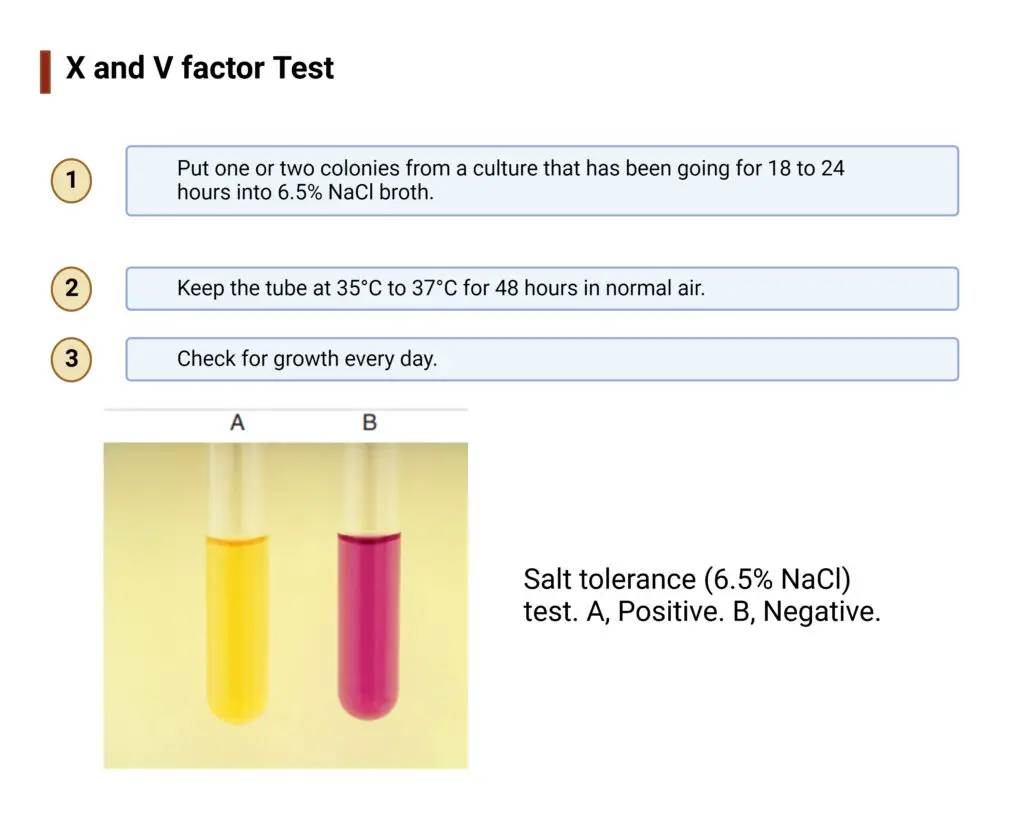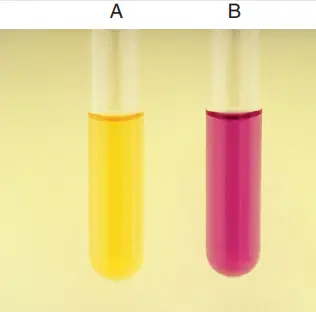Advertisements
Table of Contents
- The ability to develop in the presence of varying concentrations of sodium chloride (NaCl) has been used to distinguish between various bacteria.
- It considers the organism’s tolerance for a range of osmotic concentrations. Enterococcus faecalis, Enterococcus zymogenes, Enterococcus liquifaciens, and Enterococcus durans are all salt-tolerant Enterococcus species.
- A salt tolerance test can be used to identify enterococcal group D Streptococcus.
- Multiple bacteria, notably viridans streptococci, have been defined by their tolerance for varying concentrations of sodium chloride (NaCl) in their growth medium.
- The enterococcal group D germs can only develop when the broth or agar medium contains 6.5% NaCl.
- Many labs employ this test in conjunction with the bile-esculin test to tell group D streptococci, Streptococcus bovis, and Streptococcus lactis apart from Enterococcus species. Endocarditis caused by enterococci is a leading cause of hospitalisation and death.
- For this reason, a broth called brain-heart infusion (BHI) is employed, and it is augmented with 6.5% sodium chloride and bromocresol purple, which acts as a pH indicator.
- A visual aid is provided to facilitate interpretation of the test outcomes.
- Dextrose is also present in the soup base.
- The sugar dextrose is fermented into an acid by microorganisms.
- The media’s pH changes, transforming the colour from purple to yellow.
Objective of Salt Tolerance Test
- This test is used to find out if an organism can grow where there is a lot of salt.
- It is used to differentiate enterococci (positive) from nonenterococci (negative).
Salt Tolerance Test Principle
- Salt is a selective agent that disrupts osmotic balance and membrane permeability.
- In about 48 hours, salt-tolerant microorganisms will produce abundant growth in the broth and on solid agar in the salt tolerance medium because of the medium’s selective and differential properties.
- The first successful salt-tolerant medium was created by Hajna. A wide variety of bacteria are killed off by the high salt concentration, although salt-tolerant species like enterococci can thrive there.
- Dextrose, a fermentable carbohydrate, and bromcresol purple, a colour indicator, are both components of the Quadri formula.
- Sugar is metabolised by organisms that can thrive in the high salinity medium, and acid is produced as a byproduct of the metabolism.
- Reduced pH causes a colour change in bromcresol purple indicator from purple to yellow.
- To the contrary, enterococci thrive in salty environments. Enterococcus faecalis, Enterococcus zymogenes, Enterococcus liquifaciens, and Enterococcus durans are all salt-tolerant Enterococcus species.
Test Requirements for Salt Tolerance Test
- 6.5% sodium chloride peptone water
- Overnight culture of the test organism
- Inoculating loop or wire
- Solid culture media
- Incubator
- Bunsen burner
- Test tube rack
- Quality control strains
Media required for Salt Tolerance Test
Media: Brain-heart infusion (BHI) broth can be used instead of the individual parts by adding NaCl and indicator dye.
Components
Advertisements
| Ingredients | Gms / Litre |
| Peptic digest of animal tissue | 10.000 |
| Heart infusion | 10.000 |
| Glucose | 1.000 |
| Sodium chloride | 65.000 |
| Bromocresol purple | 0.016 |
| Final pH ( at 25°C) | 7.2±0.2 |
Salt Broth Preparation
- Suspend 86.01 grammes in 1000 ml distilled water.
- If you need to, heat the mixture to dissolve it completely.
- Dispense as desired.
- Use an autoclave for 15 minutes at 15 pounds of pressure (121°C) and 121°F.
Key Fact
- Enterococcal group D streptococci can be distinguished from non-enterococcal group D streptococci using Salt Broth, Modified.
- Testing the salt tolerance of bile esculin-positive and catalase-negative Enterococci in a medium containing 6.5% sodium chloride is a reliable way to distinguish between them.
- The high concentration of salt in this medium serves as a differential and selective agent by disrupting membrane permeability and osmotic balance.
- The 6.5% sodium chloride tolerance test is useful for distinguishing enterococcal group D Streptococcus species (Enterococcus faecalis, Enterococcus faecium, Enterococcus durans, and Enterococcus avium) from non-enterococcal species like Streptococcus bovis and Streptococcus equines.
- Carbohydrates come from glucose, while nitrogenous nutrients come from heart infusion and peptic digest of animal tissue.
- The pH indicator bromocresol purple changes colour from purple to yellow when exposed to an acidic environment.
- Salt water is a good example of sodium chloride’s use as a selective and differential agent.
- The indicator’s turbidity and, at times, its shifts in colour, both point to growth.
- Glucose usage and acid generation may also cause a shift in colour, from purple to yellow.
- Enterococcus species can be readily identified as a serological group D streptococci or biliary esculin positive isolate.
Recommended Media for Salt Tolerance Test
- Commercial HI broth with 6.5% salt from BD Diagnostic Systems’ Remel SF broth with 5% salt and sodium azide
- The Hardy Diagnostics NaCl 6.5% is found in BHI broth with a high salt content.
- The Hardy Diagnostics Tryptic Soy Broth (TSB) with 6.5% NaCl is a recommended growth medium for separating group D streptococci from enterococci.
Salt Tolerance Test Procedure
Preparation of 100 ml 6.5% NaCl Peptone Water
- Weigh 1.5 g of peptone water that has been dehydrated and 6.25 g of sodium chloride.
- Mix them with 100 ml of distilled water.
- Mix well and divide between the test tubes.
- Sterilize by putting it in an autoclave for 15 minutes at 15 pounds of pressure and 121°C.
Test Procedure
- Put one or two colonies from a culture that has been going for 18 to 24 hours into 6.5% NaCl broth.
- Keep the tube at 35°C to 37°C for 48 hours in normal air.
- Check for growth every day.

Results of Salt Tolerance Test

- Salt Tolerance Positive test: You can see that the broth is cloudy, even if the colour doesn’t change from purple to yellow. Note: Turbidity is a sign of a positive test on its own.
- Salt Tolerance Negative test: After 72 hours, there is no cloudiness and no change in colour.
Quality Control
- Positive: Enterococcus faecalis (ATCC29212) is growing; the colour is changing from red to yellow.
- Negative: Streptococcus bovis (ATCC9809) is inhibited, as shown by little to no growth and no change in colour.
Limitations of Salt Tolerance Test
- Colonies grown in sterile conditions should be tested using biochemical, immunological, molecular, or mass spectrometry techniques for definitive identification.
- It may be difficult to interpret test results while using 6.5% NaCl infusion broth because of the potential for sluggish reactions.
- Strains of Streptococcus agalactiae (group B) can multiply in medium without triggering an acid response. The medium will be turbid, but it won’t change colour.
- When inoculating broth, it’s best to use a small amount of bacteria. A turbidity-induced false-positive result could be the result of an inoculation with a large inoculum.
Salt Tolerance Test Uses
- In addition to being able to distinguish Aerococcus species from Stomatococcus and Helcococcus, salt tolerance broth can be used to distinguish Aerococcus species like A. viridans and A. urinae.
- Used to distinguish enterococci (positive) from other bacteria (negative).
- The capacity to develop in a 6.5% sodium chloride broth is used to distinguish non-beta-hemolytic strains of catalase-negative, gram-positive cocci (such as Enterococcus and Aerococcus).
References
- Tille P.M. 2014. Bailey and Scott’s diagnostic microbiology. Thirteen edition. Mosby, Inc., an affiliate of Elsevier Inc. 3251 Riverport Lane. St. Louis. Missouri 63043
- https://www.austincc.edu/microbugz/salt_tolerance.php
- https://www.bioscience.com.pk/topics/microbiology/item/239-salt-tolerance-test
- https://himedialabs.com/TD/M1290.pdf
- https://universe84a.com/collection/salt-tolerance-test/
